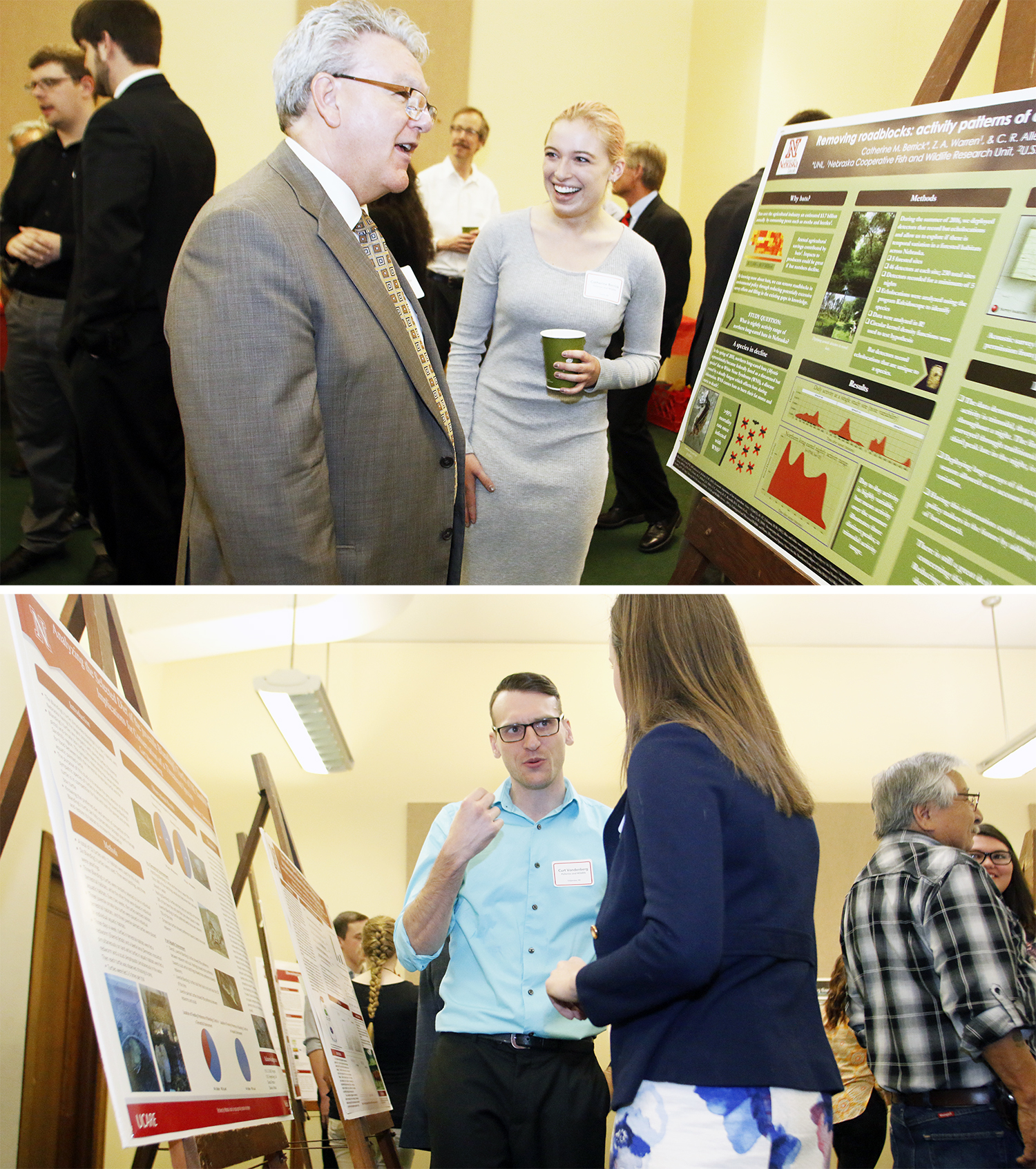
Cat Berrick and Curt Vandenberg, both fish and wildlife majors at the School of Natural Resources, were among 25 UCARE students to present their research Thursday morning at a breakfast and poster session at the Nebraska State Capitol in Lincoln.
Many of the state’s 49 senators came to meet and learn from students. All of the research presented had a state focus. Berrick presented her research on the northern long-eared bat, a federally threatened species, and Vandenberg presented his research on Blanding’s turtles, a globally endangered species but one that’s abundant in Nebraska. Avery Dresser, environmental restoration science major with SNR, also presented at the event.
The research projects each have implications for conservation and policy decisions in the state, and the students hoped to pique the interest of congressional leaders who can make a difference.
“I know that not everyone gets a chance to present important topics to our politicians, so when the opportunity came, I wanted to take full advantage of it,” Vandenberg said about the experience. “I knew I had a chance to start a spark at the capitol, which may have the potential to create a ripple effect that helps with conservation of the Blanding’s turtle.”
The research
The hook for Berrick’s study was based in this fact: Bats save agriculture industry up to $3.7 billion annually because bats eat crop pests such as months and beetles; they also act as pollinators. By knowing more about bats and their behaviors, Berrick hoped to help remove “roadblocks in environmental policy through reducing potentially excessive survey efforts.”
For her study, she posed the question: What is the nightly activity range of northern long-eared bats in Nebraska?
Using 230 bat detectors distributed on private property in five sites near Chadron, Rose, Fort Calhoun, Union and Fairbury, she recorded bats for five consecutive nights over the summer. Daily activity at each site varied widely, but mean activity showed three distinct peaks of activity throughout the night. While the first two peaks often are captured in traditional survey methods, the third rarely is.
“There is still a great deal of uncertainty about this threatened species,” she said, but the more information that is collected, the less uncertainty there is, allowing for better policy and conservation efforts to be made.
Conservation efforts were at the heart of Vandenberg’s research, too. The Blanding’s turtle is threatened throughout Canada and New York, is endangered in seven states and one province, and is a concern species in one state. The reptile is considered to be globally at risk.
“Nebraska is actually the only place it’s abundant,” Vandenberg said. “Since they are abundant here, we have a better opportunity to research why they flourish here and are declining everywhere else, which in the long-run, will hopefully help us increase populations globally.”
So he asked: Are juvenile Blanding's turtles in competition for food with painted or box turtles?
Vandenberg’s research compared 12 turtles placed in 12 habitats, six on land and six in water. Those on land were fed a redworm and beetle larva simultaneously and those in water a redworm and a scud simultaneously. Vandenberg then recorded which prey the turtles chose.
He discovered that young Blanding’s prefer to catch or eat their prey in aquatic environments. This indicates aquatic competition – the painted turtle – has a larger impact on the Blanding’s turtle that the land-based box turtle, he said, and future studies should focus on aquatic competition only. Continuing to learn more about the turtles’ preferred diets and competition can help conservation biologists “properly manage and restore” Blanding’s habitat to hopefully increase their population size.
“Conserving a species of turtle may not seem important to everyone,” Vandenberg said, “but this species helps create biodiversity, which enhances the ecosystem's productivity. All species play a vital role in our ecosystem. We just sometimes don’t realize it until after they’re gone and it’s too late.
Research at the Capitol
The UNL Research at the Capitol event, a first for the university. was modeled after others by Big 10 Network colleges, said Justina Clark, director of undergraduate research. After the breakfast, the students’ posters were moved to the rotunda where they will remain on display through Friday.
Shawna Richter-Ryerson, Natural Resources